Provost's Newsletter

December 2020
Time is a funny thing in COVIDland. Not only are we experiencing the usual dichotomy of the semester going by both excruciatingly slowly and with the speed of a bullet train, we face a kind of blurry, pandemic-inspired lack of clarity about how one day differs from another. We also face a sense of disconnectedness, as if we have somehow been away on a visit to an alternate universe where the roles and rules are different than anything we have ever known.
Well... the good news is that despite the blurry Zoom realities and the sense of disconnectedness, what we find when we look deep into the Brady Bunch squares is that we actually do have one another to rely on. We are connected and communicating--if not in quite the way we'd like, then in a way that keeps in place the ties that bind. We are a community that cares deeply about each individual person, and the connections between us form an ecosystem that is sustainable. Thank you all for not letting that ecosystem falter. If anything, it has grown stronger and more resilient as we collectively discovered our hidden strengths and capacities. That is indeed something to be thankful for.
This semester, we celebrate the full re-accreditation of the programs in the School of Education and the Counseling Master's Program (School Counseling) by the California Commission on Teacher Credentialing. The re-accreditation effort demonstrates Sonoma State's commitment to quality, rigor, and continuous improvement. That commitment is further demonstrated by faculty across the campus who have been working continuously and for untold numbers of hours to help our students transition successfully to remote instruction. We also thankfully acknowledge the work students have done to continue making progress towards their degrees under the most challenging of circumstances.
As we move forward to implement the policy changes related to AB 1460, the Ethnic Studies requirement, we also celebrate the deep commitment of our campus community to the values of equity and inclusion at the heart of Ethnic Studies and thank our faculty and administrators for working side-by-side across schools to ensure this implementation process serves as a model of collaboration, interdisciplinarity, and making a difference in a world that needs a deep and abiding focus on antiracism and the real practice of inclusion and equity.
Happy Holidays to all! Rest, recharge, and look forward to Spring!
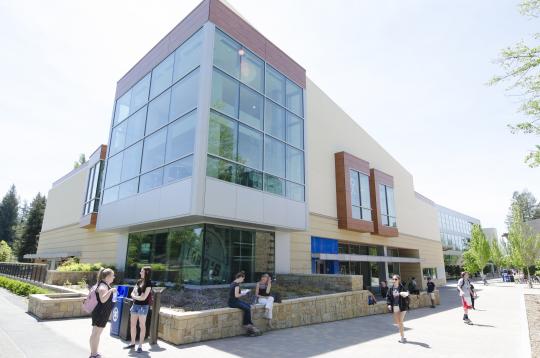
Strategic Enrollment Management Plan
Sonoma State University has developed a comprehensive Strategic Enrollment Management (SEM) Plan detailing the enrollment strategy of the university through 2024. We have focused on the next three years because of the uncertainties of COVID, of our repopulation plans for next year, and because of the continuing likelihood of budget reductions. The important piece to note are the targets for enrollment and yield rates and the goals and strategies we intend to employ. Our thanks go to the dozens of people who participated in various stages of developing the plan. If you have thoughts or suggestions for the SEM plan, please let us know at [email protected]. By design, this plan will support students from application to graduation, and our next phase of work involves developing a retention plan. Through the SEM Plan, Sonoma State formally focuses on serving our regional community, low-income, and historically underserved student populations in alignment with the goals of Graduation Initiative 2025 and our strategic initiatives and core values from the campus Strategic Plan.
Provisional Patent Granted
Alexander Sneed, and Gaven Hayden-Town.
Sonoma State University and Dr. Sudhir Shrestha, assistant professor of Engineering, have been granted a provisional patent on a low cost, hand-held device invented by SSU’s Intelligent Systems Lab to diagnose and monitor various diseases, including diabetes. This device builds upon Dr. Shrestha’s many years of research in sensing systems and reflects his dedication for developing technology that improves lives. This patent is the first of its kind for Sonoma State University, and its development has provided students with valuable research experience. We thank Dr. Shrestha and the undergraduate and graduate students of Intelligent Systems Lab for their work, and we are so excited that Sonoma State can celebrate the accomplishment of holding an active provisional patent.
Classroom Refresh Initiative
After more than two years of collaboration across the campus community, the General Purpose Classroom Refresh Initiative has released its full report. Particular thanks go to a shared governance process led by ATISS, APARC, and Dr. Elias Lopez and his working group. The report details the technology upgrades to classrooms that will ensure the highest quality teaching and learning, made possible through Provost's Office one-time funding preserved despite budget reductions. The work of the Classroom Refresh Initiative has served as a national model of shared governance to the benefit of SSU students and the campus. Distinct from the Stevenson Hall renovation, the set of projects captured in this report constitutes a first phase of improvements, set to roll out across the campus over this year and next. As funding becomes available, other projects might include painting, lighting, HVAC improvements, and other upgrades. This initiative is part of a larger set of planning projects the campus is undertaking under the leadership of Vice President Joyce Lopes.
To view the full report and for information on other current initiatives, please visit the Academic Affairs website.
August 2020
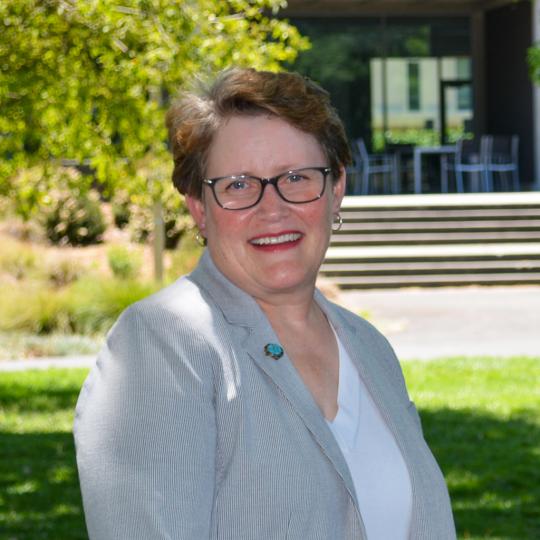
A Story of Resilience and Excellence at Sonoma State
Welcome to the 2020-21 academic year! It is a year like no other and it brings mixed emotions. We’d rather be back on campus, meeting our new students, greeting returning students and colleagues, and sharing our work in face-to-face conversations in hallways, classrooms, study spaces, and offices.
But we are in some ways better prepared to educate our students than we have ever been for any fall. We are rising to the challenge, learning new ways to transmit and share knowledge, learning new capacities, skills, and behaviors that will, in the end, help us do exactly what we need to do—make the world a more educated, more inclusive, better place. Keep reading for some stories of our successes.
The SSU Schulz Library is the first campus in the CSU to distribute laptops and other electronic equipment to students on the basis of need, and not on a first-come, first-serve basis. This collaboration with the Division of Student Affairs and the Center for Academic Access and Student Enrichment (CAASE) is a model of inclusive excellence. This fall, the library is again distributing technology to ensure that students have the resources they need to continue their educations remotely. Thanks to Dean Schneider, Gerald Jones, and the library faculty and staff!
Over our time away from campus in the last six months, faculty have won more than $4 million in grants for research, scholarship, and creative activity. In addition, the Office of Research and Sponsored Programs (ORSP) has launched the 2020-21 Koret Scholars Award, made possible by a renewed $1 million dollar, 5-year grant from the Koret Foundation. Koret has also funded our new Sonoma Mountain Connection, a program to support retention for first-time, first-year STEM students.
A new tool that is particularly important when we are not on campus to see flyers and hear from colleagues about campus events is our new interactive academic calendar—download key dates to your phone. Connection and participation are more important than ever, so join us!
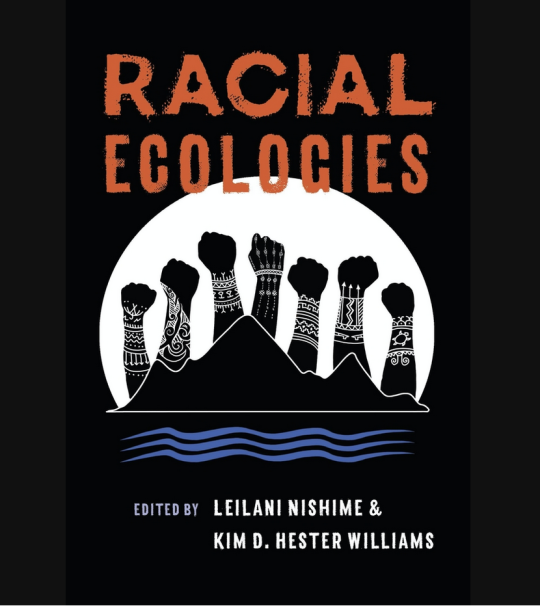
Anti-Racism Work in Academic Affairs
One of our most important initiatives this fall is our work on anti-racism. President Sakaki has called us to action, as the violent deaths of George Floyd, Breonna Taylor, and now Jacob Blake have highlighted the need to change forever the attitudes and structures that support white supremacy and interfere with racial justice. This is work each and every one of us must do. Education is where it starts:
- We are offering new Faculty Exchanges on racial justice over the next month. One of these exchanges will introduce a new Canvas site for anti-racism teaching resources.
- We are offering Teagle grants to redesign academic programs for student success. You will be able to take an anti-racist focus for the redesign, and faculty may benefit from our Teagle Fellow, a faculty member trained in anti-racism curriculum development and pedagogy. Watch for the announcement from Academic Programs of this opportunity.
- Within the Academic Affairs Call to Action, our schools are hard at work developing programs that support Black Lives Matter, encourage recruitment and retention of low income and underrepresented students, and foster inclusive excellence. Faculty are adding material to courses that focus on racial, social, and environmental justice, addressing racial and gender bias in coursework, and creating programs and pathways that increase racial diversity in the work force.
- Educate yourself with a list of books and movies on race and racism, curated and discussed in Sonoma Magazine (Link to article) by Professor Kim Hester-Williams and former Associate Professor Christina Baker.
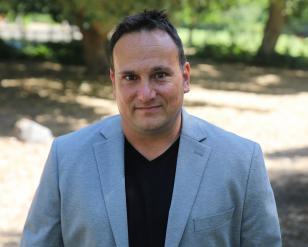
Matthew Paolucci Callahan
Dr. Matthew Paolucci Callahan has received the 2020-2021 Faculty Innovation & Leadership Award from the California State University, primarily for his work in developing faculty support for teaching remotely. Dr. Callahan is the Faculty Fellow in the Center for Teaching and Educational Technology (formerly the Faculty Center). Congratulations, Matthew, and thanks for promoting teaching excellence in all modes!
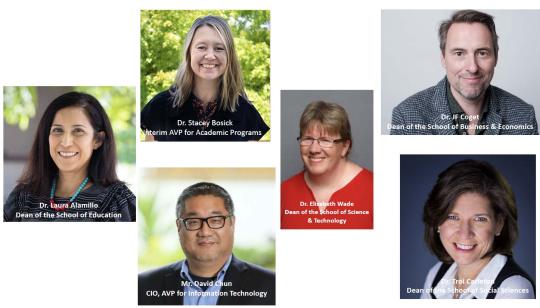
New Academic Affairs Leadership Team Members
Welcome to our new deans and AVPs in Academic Affairs!
- Dr. Laura Alamillo - Dean of the School of Education
- Dr. Stacey Bosick - Interim AVP for Academic Programs
- Dr. Troi Carleton - Dean of the School of Social Sciences
- Mr. David Chun - CIO, AVP for Information Technology
- Dr. JF Coget - Dean of the School of Business and Economics
- Dr. Elisabeth Wade - Dean of the School of Science and Technology
December 2019
Gratitude for a Successful Semester
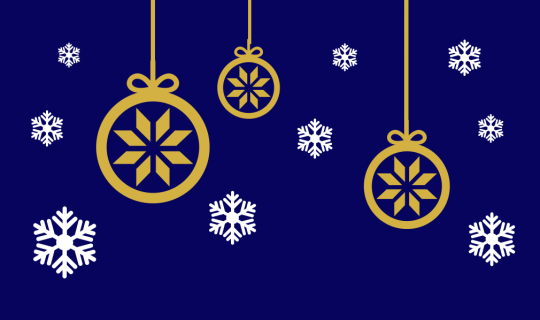
As we make our way to the end of the semester and ease into our winter break, I want to extend my gratitude to all SSU faculty and staff for your work in support of our students. Once again we have experienced a challenging fall, and once again we have been reminded of the power of our community to adapt in the wake of fires and other natural disasters.
I am particularly excited this year to have launched two important initiatives to help better connect us as a division and as a university community. The first is the Academic Affairs Events Calendar. This calendar is being constantly updated by deans’ office staff and is our first attempt at aggregating all of the amazing intellectual, cultural, and artistic events happening in our division into one convenient place. We also have posted our first-ever Academic Affairs Strategic Budgeting Report, which lays out our budget model, challenges, and goals for supporting SSU’s strategic priorities and core values.
These initiatives are but two examples of the hard work being done in Academic Affairs in support of student success, academic excellence, leadership cultivation, and transformative impact. I am proud to work with so many dedicated faculty and staff who show up every day to make SSU better. Thank you for your dedication to Sonoma State. I wish you all a restful and productive winter break.
Dean Lynn Stauffer
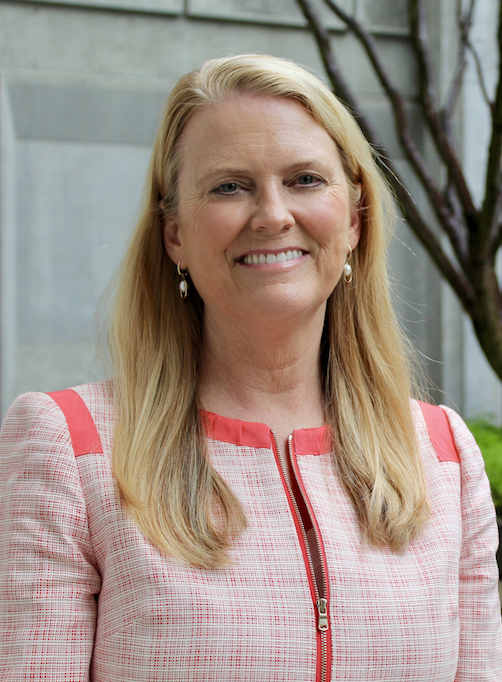
After serving for a decade as Dean of Science and Technology, Dr. Lynn Stauffer has decided to return to the faculty at the end of this academic year. A leader with incredible integrity and purpose, Lynn has led the School of Science and Technology through a time of institutional change. Lynn has brought a focus on STEM diversification, student success, and faculty support to the school. Under her leadership, the school has grown a strong undergraduate research program culminating with the Science Symposium; implemented the School’s interdisciplinary STEM First Year Experience; established the SSU Makerspace and the Dream, Make and Innovate Sophomore Year Experience; and advanced the Center of Environmental Inquiry to its current position of strength.
Her passion for broadening participation in STEM includes the growth of MESA, SHIP, Women in Tech, and the Tinker Academy. Lynn leaves a strong legacy of engagement with higher education and with our community. She has contributed to the CSU through COAST, CSUPERB and STEM-NET, while also engaging with our community the Sonoma County Workforce Investment Board and the Career Technical Education Foundation.
Lynn truly embodies positive leadership in public higher education. All of us—and especially our students—are lucky that she will continue to teach at SSU for years to come. I personally am deeply grateful for Lynn’s leadership and look forward to continuing to work with her through this academic year.
Student Success GI 2025
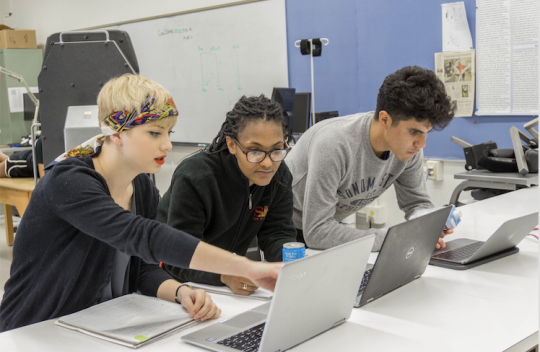
We have a lot to be proud of in our efforts to improve graduation and retention rates for all students at Sonoma State University. As our GI 2025 Progress Update 2019 demonstrates, SSU has made tremendous strides towards serving all students—regardless of background—with integrity. Our four-year graduation rates have improved by 8% in the last two years, and this remarkable progress has been made possible by the institution-wide commitment to helping all students succeed. Our multi-pronged strategy has been a true campus effort involving every division and every department. For example, we have improved our staff advisor to student ratios from 1 to 1400 in 2017 to 1 to 400 in 2019. This effort has allowed us to build a truly integrated advising model involving both staff and faculty advisors.
We continue to hire new tenure-track faculty across the disciplines also roll out technology services (including LoboConnect, electronic transcripts, Curriculog, and AdmitHub) in support of academic excellence and student success. In terms of the physical layout of how we support these priorities, we have consolidated academic student support to the first floor of the library, allowing students an opportunity to seek advising, tutoring, and support in one place.
We also have more people supporting our Accessible Technology Initiative than ever before: Dr. Sandra Ayala is our first-ever Faculty Fellow for Accessible Technology this year and we have a new IT analyst, Brad Starkey-Owens, with expertise in accessibility supporting our efforts as well. You can visit the new Universal Access Hub in the IT suite for support and training.
August 2019
Welcome Back
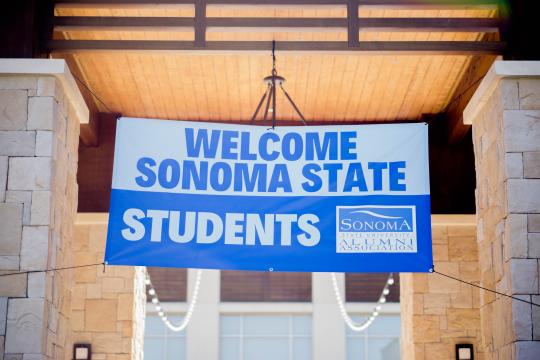
I am thrilled to welcome the entire SSU community to the 2019-20 academic year. Many staff at SSU have been working hard all summer long to prepare our departments and facilities for the return of students and faculty this fall. I was very excited to attend new faculty orientation and meet our 16 new tenure-track faculty.
We are working hard in Academic Affairs to serve all students, faculty, and staff at SSU. Please take the time to read over our 2018-19 Division Accomplishments to see just how many initiatives and projects we undertook and completed last year with the support and involvement of faculty, staff, and students. Thanks to our collective commitment to working collaboratively, we are advancing our strategic priorities of student success, academic excellence, leadership cultivation, and transformative impact. We worked together last year express and support creative ideas around curriculum, a division strategic plan, professional development, and advising, to name a few major undertakings. With incredible faculty leadership, we built and eventually passed a distinctive, meaningful GE curriculum. We continued to expand our training on bias to ensure more inclusivity in our teaching, learning, and hiring practices. We created a blended advising model that leverages the skills and expertise of both faculty and staff advisors to support each other and our students.
I am also proud that we set aside $3M to support classroom renovations so we can bring all classrooms to a basic standard over the next 2-3 years. We now are developing new classroom standards in consultation with faculty and students so classrooms of the future can better meet teaching and learning needs at SSU. The ongoing classroom conditions survey developed with APARC help us meet those standards for years to come.
This year will bring many more opportunities for meaningful conversation and collaboration.
Sustainability, Responsiveness, Resilience
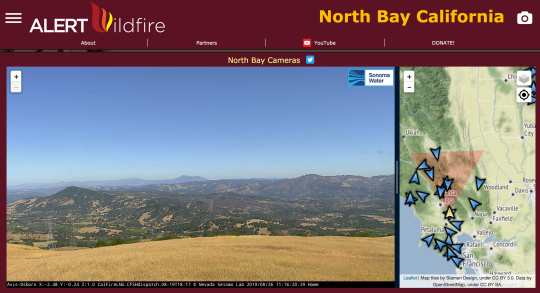
Since the fall 2017 wildfires, our dedicated faculty and staff have been positioning the university to be a leader in fire ecology, responsiveness, and resilience. SSU’s Anthropological Studies Center Director, Dr. Thomas Whitley, has received significant grants to work with Cal Fire to undertake field review, forest health, and vegetation management projects related to fire suppression and fires across California. This important archeologic work helps ensure appropriate preventive and recovery work related to the increasing number of wildfires in the state.
In May, SSU placed two fire-alert cameras at the Fairfield Osborn Preserve. The cameras feed data into a high-speed internet microwave system that can be accessed by experts across the state. As part of the North Bay Fire Alert System, these cameras help first responders spot fires quicker than ever before. Engaging students in research about fire ecology and fire prevention is an important aspect of many faculty members’ work at SSU. One strong resource for ideas regarding the connection of place to curriculum is the Resilience Studies Consortium, which promotes place-based educational opportunities. Our campus contact is Dr. Laura Watt.
Our Sustainability efforts are poised to offer many opportunities for faculty, staff, student, and community participation as we launch the President’s Sustainability Advisory CouncilPresident Sakaki signed the Second Nature Climate Commitment in April 2019. This council will be the driving force behind propelling SSU to become a recognized leader in sustainability and environmental inquiry. As part of these efforts, we responded to calls to elevate SSU’s Center for Environmental Inquiry from a school-based center to a university-based center. Effective this fall, CEI is housed organizationally in the Office of Research and Sponsored Programs. Dr. Claudia Luke will co-chair the President’s Sustainability Advisory Council with Craig Dawson. If you want to get involved in the council, please watch for the calls for participation from our various shared governance groups. We are looking for faculty, staff, students, and community members to support our sustainability efforts.
Teaching and Learning @ SSU

At Convocation this year we heard inspiring talks about teaching and learning from two of our 2019 faculty award winners, Dr. Jeffrey Baldwin (Excellence in Teaching) and Dr. Michelle Goman (Excellence in Scholarship). Continuing to share ideas and learn from each other is one of the great joys of working in higher education. Jay Howard’s "How to Hold a Better Class Discussion" provides some great tips on how to facilitate active learning and broaden student participation in our classes. Keep in mind that our Faculty Center offers pedagogy, Canvas, and inclusive excellence workshops throughout the year. Dates and times for this semester will be posted soon.
May 2019
Gratitude and Welcome to New Leadership

The commencement season is an incredible time of year as it provides us with an opportunity to celebrate everything that is positive and impactful about the work we do at SSU. First and foremost, I would like to thank every single faculty, staff, volunteer, alum, and community member who has helped our students get to this stage in their lives. It’s time to graduate! I also want to thank Dr. Maureen Buckley and Dr. Karen Thompson for exhibiting tremendous leadership as interim deans over this past year. I am thrilled to welcome two new interim deans, Dr. Dan Petree (Business and Economics) and Dr. David England (School of Education) starting June 3. I also am very happy to welcome our new AVP of Admissions and Recruitment, Barbara Godoy, to campus. Barbara started on May 6, so please stop by her office on the second floor of Salazar and welcome her to campus!
Celebrating Research and Creative Activity
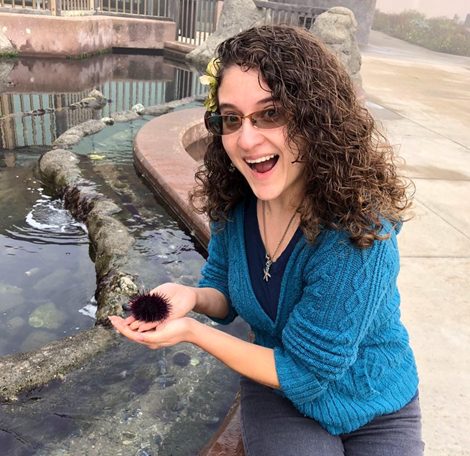
The month of May has brought us many occasions for celebration of research and creative activity. I am very excited for Jazmyne Gill, who is earning an M.S. in biology at SSU, as she recently won a Career Development Grant from the American Association of University Women. Ms. Gill’s research is on climate change as it is expressed through heat-shock proteins and purple sea urchin larvae. She is a passionate scientist and educator who dreams of getting her Ph.D. and eventually becoming a biology professor.
Ms. Gill is one of hundreds of students who benefit every year from the dedication of faculty to support student research. Our recent Week of Research and Creative Activity gave us a chance to celebrate our collective dedication to research, scholarship, creative activity, and mentorship. More than 500 students and faculty exhibited their projects and shared their expertise with the broader campus community over the course of the week.
Finally, I am thrilled to congratulate Professors Rajeev Virmani and Ben Ford for their $586,000 NSF grant. Maker Challenges to Promote Math Learning among English Language Learners aims to promote fourth- and fifth-grade student engagement with STEM through a maker-based active learning curriculum. This innovative project has the potential to transform how we teach mathematics in our schools and provides a powerful example of our commitment to equity, inclusion, and transformative impact at SSU.
Summer is upon us
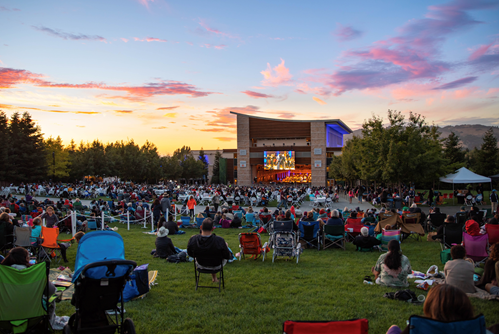
Summer is almost upon us! After commencement, our collective attention turns to the glorious months of June, July, and August. For many of us, this means turning our attention to research and creative projects. For others, it means focusing on projects that will help the campus prepare for the fall. For faculty who have not fully mapped out the next three months, I recommend this brief article by Anastasia Salter on "Four Suggestions for Planning a Productive Summer." I also really enjoyed Junior Prof’s Making the Most of Summer Plans for its focus on realistic goal setting and decision making. As for my own plans, I look forward to attending Summer at the Green concerts, hiking in Switzerland, and serving on the Modern Language Association’s Katherine Singer Kovacs Prize committee for a third and final year. Out of more than 50 nominees last year, the winner was B. Christina Arce’s México's Nobodies: The Cultural Legacy of the Soldadera and Afro-Mexican Women, which I highly recommend to anyone interested in Latin American race, gender, and women’s studies. I also look forward to re-reading Professor Kathryn Chang’s co-authored article, “The Immiserizing Growth During the Period of China’s Cultural Revolution,” which was published a few months ago in The Chinese Economy.
April 2019
SSU Welcomes New Students and Celebrates Research

Seawolf Decision Day is quickly approaching, and with it comes our chance to celebrate everything we appreciate about Sonoma State. We anticipate approximately 3,000 admitted students and their families visiting this weekend to learn more about all SSU has to offer across our five academic schools, at our incredible preserves, the Green Music Center, and through student life. As we open our doors to more transfer students, SSU continues to signal our commitment to serving students of all backgrounds and doing so with integrity. Thank you for being part of this incredibly impactful and important work!
Part of what makes Sonoma State special is the strong research profile of our faculty and our collective commitment to integrating students into research, scholarship, and creative activities. As we prepare for our first-ever Research and Creative Activity Week this month, I am pleased to highlight the research of two faculty in Science and Technology. Dr. Owen Afinson in Geology is co-leading the American Geophysical Union upcoming conference on Large-Scale Volcanism in the Arctic. The conference will provide an opportunity for researchers from across the disciplines to come together to share knowledge and eventually create a framework for future Arctic research. I also want to congratulate Dr. Daniel Crocker, Biology, for his grant from the Office of Naval Research for a project on "Developing Metrics of Animal Condition and their Linkage to Vital Rates." As Dr. Crocker describes in his abstract, this research focuses on elephant seals with the goal of determining "how body condition influences wildlife health and reproduction."
Serving SSU Students with Pride
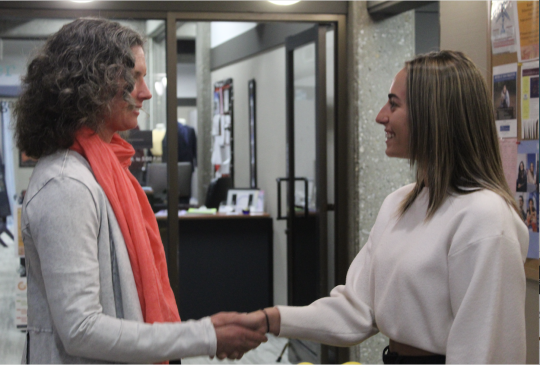
Over the past month, I have had the privilege of attending two events that highlighted our talented students. Our Career Center held a Career Advising and Handshake Booth pop-up in its new home in International Hall. SSU students were present to teach best practices for shaking hands, meeting people, and maintaining eye contact during interviews. While other students helped me pick out appropriate interview clothes from the donated clothing rack, representatives from Target were on hand to provide feedback on student resumés.
Student Talent on Display
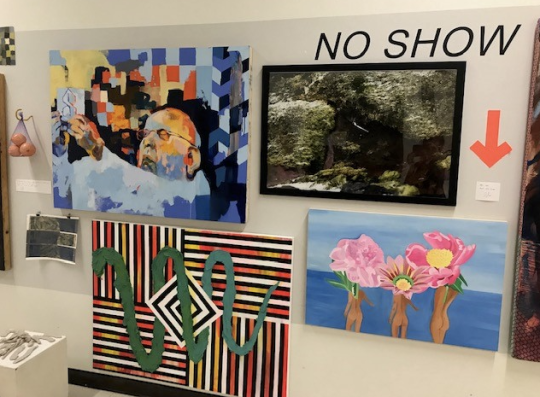
Our students’ talent is on display in the University Art Gallery 2019 Juried Student Exhibition. The beautifully curated show includes art in a variety of media created by SSU students. Jurors for the show were Susie Kantor, Associate Curator of Visual Arts at the Yerba Buena Center for the Arts, and Bay Area artist Taravat Talepasand. As an added bonus, I also invite you to visit the intriguing “No-Show Show” in the corridor by the Department of Art and Art History. Students whose work does not appear in the Juried Student Exhibition has been hung in the “No-Show Show” for all to see.
The Provost Recommends...
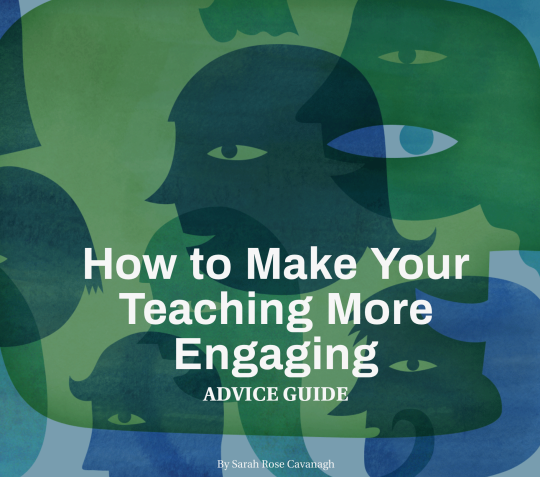
This month I recommend "How to Make Your Teaching More Engaging" by Sarah Rose Cavanaugh. This article probes intriguing connections between emotion and cognition, learning and community, and teaching and storytelling. Cavanaugh includes numerous tips on getting information through to our students. She also recommends a podcast, Teaching in Higher Ed, focused on “the art and science” of teaching and learning.
March 2019
Updates from the Provost
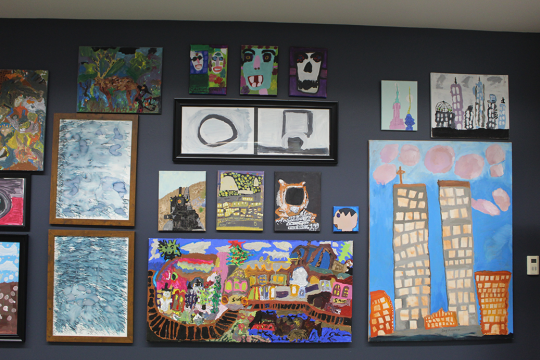
Spring break is just around the corner and spring is definitely in the air at Sonoma State. This is a good time to stop and be thankful for the opportunity we have to work in public higher education and to support our students at SSU. We have much to be thankful for at the institution and in this beautiful part of the world, but we also have much work to do to support our surrounding communities impacted by the recent flooding. You can read more about how to support recovery efforts.
I recently had the opportunity to attend the opening of the University Library’s incredibly uplifting Alchemia exhibit. Featuring the work of local artists with developmental disabilities, the exhibit highlights the joy and expressivity made possible through art. If you want to see first-hand the impact non-profits can have on individuals and communities, be sure to see the exhibit before it closes on March 25.
We have many accomplishments to celebrate both on campus and off. This month I want to highlight a new publication in the Personality and Social Psychology Bulletin by Professor Heather J. Smith of the Psychology Department. The article, “Disapproved but Tolerated,” is on the link between respect for and tolerance of under-represented groups. Written by Professor Smith with a group of internationally recognized scholars, the publication describes two separate studies centered on certain group members' respect, disapproval, and tolerance for other groups. At Sonoma State, we are fully committed to moving beyond tolerance to a deeper understanding and appreciation of all cultures and races. Dr. Smith's latest publication reminds us how fortunate we are at Sonoma State to have many faculty engaged in research that aims to further our understanding of how to build a more inclusive and equitable society.
Transfer Student Success

We have good news to celebrate! Sonoma State is No. 1 in the CSU for two-year transfer graduation rates. Thanks to the hard work of faculty and staff alike, 62.6 percent of our transfer students now graduate within two years. This means that our transfer students are getting the classes they want and need to graduate in a timely fashion. It also means that our collective focus on creating transfer-friendly curricula across our majors is helping students discover two-year pathways to graduation. Student Affairs built a Transfer and Transitions Center dedicated to helping all transfers, including veterans and those needing additional assistance navigating the university. Our transfers have access to timely progress to degree, which in turn lowers their debt. They also have relatively high early-career earnings compared to graduates of other institutions.
All of this good news helped Sonoma State achieve a No. 12 in the nation ranking in Money magazine's 2019 list of Best Colleges for Transfer Students.
Currently we are proposing to lift impaction for transfers and thereby make it even easier for students to transfer to SSU, including as lower-division undergraduates or as spring applicants. These are just some of the impactful ways in which Sonoma State continues to focus on lifting educational attainment throughout our region.
Social Justice

Sonoma State was fortunate to have another successful Social Justice Week this spring. Students, faculty, staff, alumni, and community members had access to 34 talks covering a wide range of topics. The highlight was a lecture by New York Times columnist Charles Blow, who delivered the Andréa Neves and Barton Evans Social Justice Lecture Series at the Green Music Center on February 26. In conversation that afternoon with Professor Juan Salinas, Mr. Blow spoke with students at The Hub about race and racism in the United States. Later in the day, hundreds of audience members at the Green Music Center heard Mr. Blow speak passionately about structural racism, the power of voting, and the need to denounce hate at all levels of our political and social systems. Mr. Blow’s inspirational messages resonate with our own campus community and with the entire week of social justice programming. As we continue to find ways to structure productive dialogue and trainings to help us strengthen our own commitment to diversity and social justice at Sonoma State, we also can and should continue to find inspiration from those who have committed their lives—in both past and present—to shaping a better society for all.
Writing Our Way to the Future
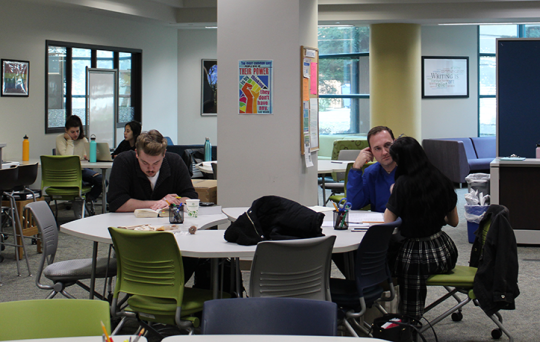
This month I recommend an article from Teaching, The Chronicle of Higher Education’s weekly pedagogy newsletter. “How One Instructor Shows Her Students that Good Writing Matters” is chock-full of ideas about how to connect the classroom experience to the real world, regardless of discipline. Some faculty report assigning interviews about real-world writing to their students, while others create writing assignments about where students envision themselves ten years from now. Still others ask students what skills they believe they need to be prepared for graduation and then integrate the building of those skills into their classes. SSU professor Glenn Brassington reminded me on a rainy afternoon recently that we also need to give students time to process and think, so he invites students who are able and willing to go on a walk during breaks to clear their minds and prepare their minds and bodies for more learning. Our Faculty Center has many workshops on teaching and learning, and if you have ideas for sessions you would like to offer or take, please let them know!
February 2019
Updates from the Provost
The spring semester is well underway, and this is a great time to thank every faculty and staff member at SSU for the work we do collectively to educate and support our students.
I was thrilled to learn that 54 faculty applied for Research, Scholarship, and Creative Activity Program funding. On the recommendation of the Faculty Subcommittee on Sponsored Programs, some of the increased funding available this year includes a limited number of Assigned Time awards. All awardees will be notified on March 1.
These are just some of the ways in which we are increasing support for research at SSU. Please mark your calendars for the Research and Creative Activity Symposium, which will feature student and faculty work during the week of April 29-May 2 in the Student Center. This is a great time to thank Dr. Daniel Malpica for stepping into the role as Director of the McNair Program. His leadership has helped bolster our commitment to integrating student research and faculty mentorship.
In the spirit of supporting RSCA, this month I'd like to recommend Scott Jaschik's recent interview with Raphael Folsom, "How to Get Grant Money in the Humanities and Social Sciences." If this piece sparks ideas for you, please reach out to Steve Karp, our Associate Vice President for Research, to identify funding opportunities. Under his leadership, the Office of Research and Sponsored Programs has increased pre-award support offers mentoring via workshops, one-on-one discussions, and grant-writing assistance.
We have many faculty and staff accomplishments to celebrate. I am proud to congratulate Dr. Adam Zagelbaum for the Western Association of Counselor Educators and Supervisors Conference 2018 Outstanding Publication Award. The award was given for the prison education video, "Group Counseling with Inmates: San Quentin Prison." I also want to congratulate Dean Karen Schneider for being elected to a three-year term on the American Library Association's executive board.
I am proud to work with so many talented faculty and staff. If you have ideas about how we can better highlight people's achievements, please send them to me.
Thank you for the leadership you provide both on and off campus in service to our students and our strategic priorities.
In gratitude,
Lisa Vollendorf, Provost
January 2019
Welcome to Spring 2019!

As we kick off a new semester, you might enjoy James M. Lang's article on How to Teach a Good First Day of Class. The article provides great tips for faculty across the disciplines and reminds us of the power of education to help students flourish and grow.
As we continue to prioritize faculty hiring, I am pleased to report that we already have six new faculty who will join SSU this fall. Congratulations to AMCS, CCJS, Sociology, Psychology, and Early Childhood Studies for their recruiting efforts. Our other searches are moving along and should result in hires later this spring. While we were advised not to sponsor visas this year, we are committed to sponsoring them starting with the next hiring cycle. To everyone participating in faculty and staff recruitment this year, thank you for your incredible effort.
We have many openings for faculty to serve on administrative search committees. Hiring is among the most important work we do at SSU, and we need diverse representation on our administrative recruitment committees to do this work effectively. Please consider stepping forward for one of these important leadership opportunities by putting your name forward to the Academic Senate at [email protected].
Together we have created a preliminary strategic plan for the Division of Academic Affairs. Schools and other units (such as the Library, Records, Admissions, and I.T.) are now poised to carry the plan to the next level of implementation. You can see other draft division plans posted on the strategic plan website. We also are moving forward with strategic budgeting, which will include spring budget planning starting with the schools and units up to the division level. Please mark your calendars for the spring Budget Forum (Tuesday, March 12 from 2-4 p.m.). The forum provides a chance to learn about the budget outlook and to share ideas about how to build alignment between resources and strategic priorities.
Thank you for the work you on behalf of and with our students.
In gratitude,
Lisa Vollendorf, Provost
Electronic Transcripts Now Available
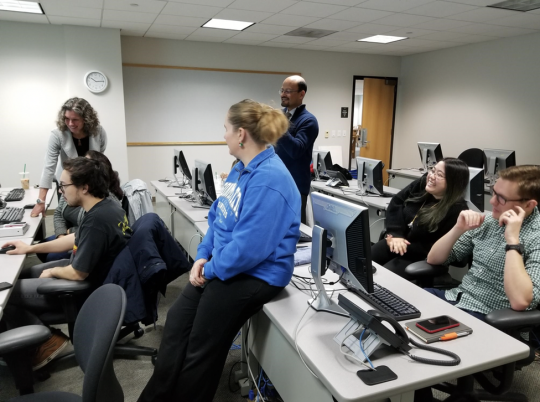
I am thrilled to announce that we recently made electronic transcripts available at Sonoma State University. Before this semester, if a current or former student wanted to order a transcript, you had to go in person to the Records office. There you would fill out the form, sign it, pay the postal fee (if applicable) and then, in a week or two, you would get something in the mail.
Now, thanks to the incredible collaboration between Associated Students, Records, IT and other Academic Affairs staff, if you want a transcript, you can do it al online in just a few quick steps.
If you need a transcript for a good driver insurance discount, applications to graduate or professional school, or for job application purposes now can get them almost instantly. In our pilot, we had Associate Students leaders Christina Gamboa and John Dunstan order transcripts, along with two alumni. The transcripts arrived within 10 minutes to their inboxes.
Read more here about how excited we are to launch this service!
This is one of the first major projects we have undertaken in collaboration with student, faculty and staff input to streamline forms and make our business services more student friendly. We are working to streamline and digitize more processes, so stay tuned for more exciting news to come!
In gratitude,
Lisa Vollendorf, Provost
October 2018
A Bridge to Success
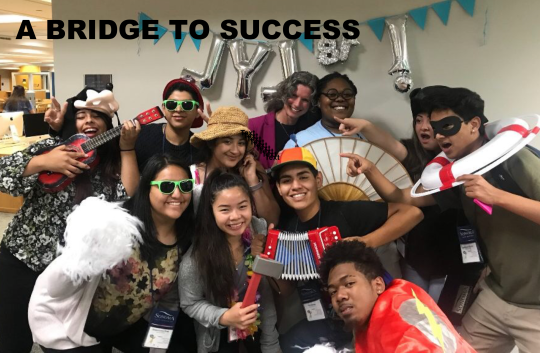
By Claudia Moore, Student Assistant, Office of the Provost
Over the past summer, Sonoma State launched an expanded version of Summer Bridge. This program helps historically low-income and first-generation first-time freshman college students as they transition to college. Bridge gives them an opportunity to get to know our campus, build community with their peers, and meet with advisors and faculty before fall classes begin.
In the past, Summer Bridge served only EOP students. This summer, because of charitable donations from Kalmanovitz Charitable Foundation and generous gifts from the Federated Indians of Graton Rancheria, the program expanded to include EOP, Federated Indians of Graton Rancheria, and students from the PUERTA project, which prepares underrepresented educators to become teachers. In total, 187 students got the opportunity to take English and Math classes while also building skills to prepare for the transition to university. The academic emphasis exposed students to data gathering, statistical analysis, college-level writing, and presentation skills. These activities gave students as taste of college course work while also familiarizing them with the campus. This year’s Summer Bridge was a true collaboration and development between both academic and student affairs divisions, which truly met our president’s objectives around refocusing our campus priorities on a student-centered and student-first approach to we service our community.
The academic portion was added as a part of Sonoma State’s Graduation Initiative (GI2025), helping give students a firm foundation for success. Summer Bridge shows an immediate impact on student success and retention for our most vulnerable student populations. Dr. Karen Moranski, Associate Vice President for Academic Programs, stated that "Summer Bridge has a 'ripple effect' by giving students a community to come back to before school even begins and helping them feel connected to others in their first semester." The importance of Summer Bridge is not solely academic; it also helps build lifelong communities.
Summer Bridge Student Leader and third-year SSU student, Ja'Keemah Seals mentored a group of 8-10 first-generation college students in "Team Joy" during Summer Bridge. Ja’Keemah had gone through Summer Bridge . The program gave her a chance to get to know other students and bond with other over a shared experience while build a community, one she is still in close contact with today. Coming back as a Summer Bridge Student Leader gave her the opportunity to give back to the students and the program. One of Ja'keemah's proudest moments as a Summer Bridge Student Leader is when “one of the students said that she didn’t believe she would fit in or even be able to attend [Summer Bridge] at first, and by the end she was so happy to be a part of her bridge team."
Summer Bridge gives students a strong support system to fall back on when times are difficult. Ja'Keemah Seals emphasized the importance of finding a home away from home on campus; "Finding your community is important because your real family isn't here. People who accept you as valid and visible are key to success in college." Ja'Keemah's main goal of Summer Bridge was to build a community for her students. "Even if they didn’t feel like a part of Team Bridge, I wanted them to feel a part of Team Joy." One of the students on Team Joy told EOP leadership: "My Bridge leader Ja'Keemah was the most comforting gentle person I have ever met. She made me feel comfortable and helped me make SSU my home."
It is not only the program that makes Summer Bridge so special; it is its leaders as well. For Ja’Keemah making sure her students would succeed in every part of college life was essential. She went above and beyond and helped her students find on-campus jobs, build resumes, register for classes, and make friends so they could truly be ready for everything once they made the transition to Sonoma State.
In providing an opportunity for all students to achieve success in the Summer Bridge program delivers on SSU’s strategic core values of diversity, connectivity, and adaptability. Summer Bridge helps students from diverse backgrounds prepare for success. Importantly, it also gives incredible students like Ja'Keemah Seals the opportunity to build leadership skills.
Reaching High: Professor Kim Hester Williams
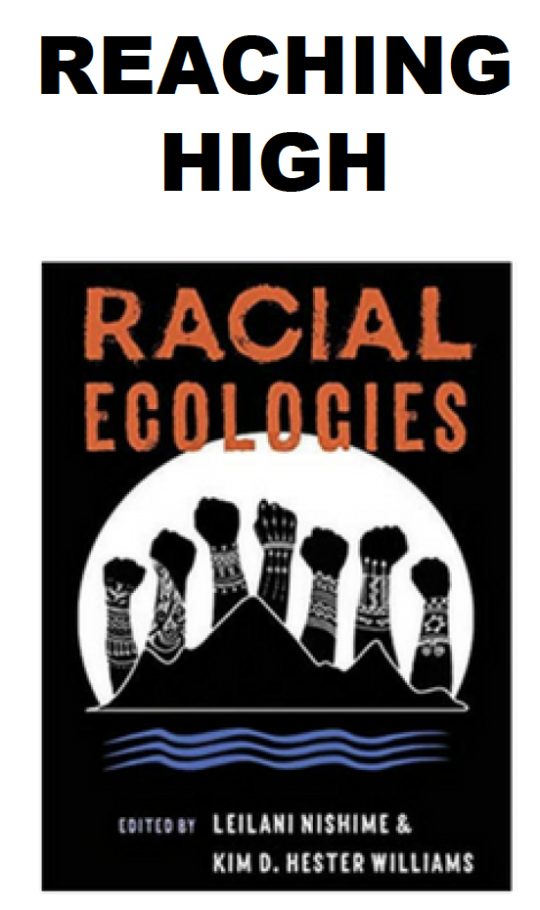
By Mariah Ponce, Student Assistant, Office of the Provost
Professor Kim Hester Williams has co-edited a new volume of impactful essays about diversity and social justice. Racial Ecologies(University of Washington Press, July 2018) explores the responses of communities of color to environmental crises. Taking a global view, the essays explore the ways in which race, gender, nationality, and colonialism continue to shape our communities and our environment. Professor Claire Jean Kim said of Racial Ecologies, "This is a powerful and important book that should be read by everyone concerned with how to understand and address the ecological crisis that is upon us."
Dr. Hester Williams has been at SSU for over 20 years and says that “working at Sonoma State has been nothing but positive.” A specialist in nineteenth-century American literature, she loves helping students understand the past so they can prepare to help create a sustainable, inclusive future. Her commitment to our students is a strong example of our collective dedication to student success and academic excellence at SSU.
Professor Hester Williams’ teaching and writing also embrace our institutional core values of diversity, sustainability, and adaptability. Helping students to become critical thinkers and responsible members of society is not only beneficial to the campus, but to the broader community as well. Through both teaching and research, Dr. Hester Williams is inspiring our students to be leaders and have a transformative impact both on campus and in the world.
Focus on Student Success
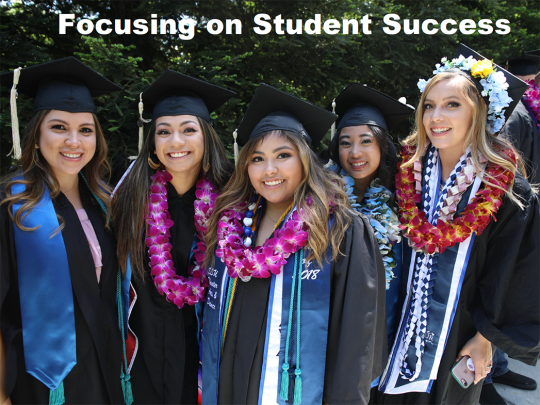
Focus on Student Success Sonoma State University has made great strides towards our Graduation Initiative 2025 goals. A recent preliminary report provided by the Chancellor’s Office shows us making remarkable progress towards almost every single goal.
Importantly, 34.8% of first-time, first-year students graduate from SSU in four years. Our transfer two-year graduation rates are improving as well: this year we hit 62.2%! These are among the best graduation rates we have seen at Sonoma State and also among the best in the system. These results would not be possible without the dedication and thoughtful approach to advising and systems improvements that we have as an educational community at SSU. Our students graduate with less debt and in a timely fashion thanks to our commitment to student success.
SSU strives to serve all students with integrity. This includes providing meaningful advising, meeting student demand for required classes, and giving students access to the support services they need to succeed at university. Faculty and staff support our students every day through formal and informal advising sessions, academic experiences, and co-curricular programming. We want to ease the bureaucracy and decrease reliance on paper, so we are also taking a systems-based approach to helping students succeed. New tools to support this effort include: Platinum Analytics for predicting course demand; Tableau for data visualization; and the Student Success Collaborative for individualized advising.
Early Childhood Studies has some of the best four-year graduation rates at SSU. The department’s chair, Dr. Chiara Bacigalupa, has worked collaboratively with her colleagues to create a strong advising and mentor system for all majors. All tenured and tenure-track faculty participate in advising, as do some compensated lecturers. The system provides training for new advisors to learn the ropes and also has checks and balances in place to minimize mistakes. New faculty advisors shadow more experienced advisors before taking over advising sessions on their own. Following the tried and true model used by master teachers nationwide, this approach helps the department support and meaningfully advise large numbers of majors. ECS has some great advising practices that can be replicated throughout the university! Taking a page out of the playbook of Early Childhood Studies may be an option for other departments on campus.
We have a lot of progress to make if we are going to meet all of our GI2025 goals. You can read more about those goals and see our preliminary progress report on the Graduation Initiative Group website.


